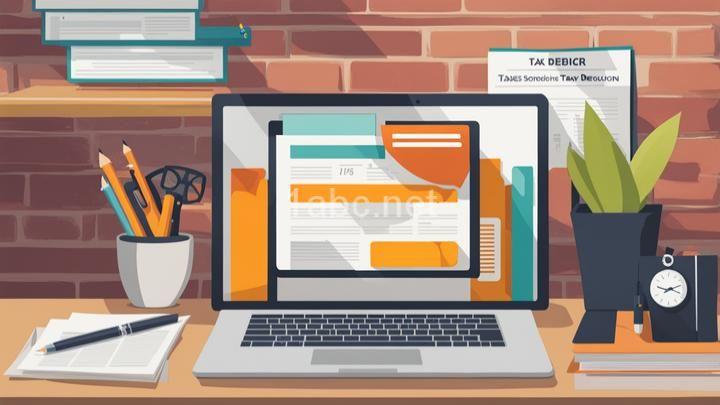The Art of Itemizing: How to Optimize Deductions for Greater Tax Savings

Introduction:
Welcome readers to the blog post! We're here to help you navigate the world of tax deductions and show you how to optimize them for greater savings. Taxes can be intimidating, but with a little guidance, you can take control of your deductions and keep more money in your pocket. So, let's dive in and explore the art of itemizing!
I. Understanding Itemized Deductions:
A. Definition and Purpose:
Itemized deductions are expenses that you can subtract from your taxable income, reducing the amount of tax you owe. The purpose of itemizing deductions is to provide relief for certain expenses that individuals may incur throughout the year. It's important to note that itemizing deductions is different from taking the standard deduction, which is a fixed amount set by the IRS.
B. Eligible Expenses:
Now that you know what itemized deductions are, let's take a look at some common expenses that can be itemized. These include mortgage interest, medical expenses, state and local taxes, charitable donations, and more. However, there are limitations and requirements for each expense category, so it's essential to familiarize yourself with the IRS guidelines to ensure you qualify for the deductions.
II. Organizing Your Deductions:
A. Gather Necessary Documentation:
To make the itemization process smoother, it's crucial to collect all the necessary documentation supporting your deductions. This includes receipts, statements, and any other proof of expenses. It's a good idea to keep a digital record of your expenses throughout the year using tools or apps that can help you stay organized and easily access your records come tax time.
B. Categorize Your Expenses:
Categorizing your expenses can save you time and make itemizing deductions a breeze. Create categories and subcategories based on the IRS guidelines to ensure you're capturing all the eligible expenses. For example, you can have categories like "Home-related expenses," "Medical expenses," "Charitable contributions," and so on. Having a well-organized system will make it easier for you to locate and calculate each deduction accurately.
III. Maximizing Deductions:
A. Timing Strategies:
Timing certain expenses can play a significant role in maximizing your tax savings. For example, if you have the means, consider prepaying your mortgage interest or making charitable contributions before the end of the year to claim those deductions on your current tax return. However, it's essential to be aware of any limitations or deadlines associated with these timing strategies, so you don't miss out on potential savings.
B. Taking Advantage of Lesser-Known Deductions:
While most people are aware of common deductions like mortgage interest and charitable contributions, there are several lesser-known deductions that you might be eligible for. For instance, if you're paying off student loans, you may qualify for the student loan interest deduction. Additionally, some states allow you to deduct the sales tax you paid throughout the year. Explore these lesser-known deductions and find out if you're eligible to claim them to maximize your tax savings.
IV. Consulting with a Tax Professional:
A. Benefits of Seeking Professional Help:
Navigating the complex world of deductions can be overwhelming, and that's where a tax professional can become your best ally. They have the expertise and experience to guide you through the process, ensuring you're taking advantage of every deduction you're entitled to. Seeking professional help is a wise investment, as it can potentially save you more money than you would on your own.
B. Finding a Reliable Tax Professional:
When it comes to choosing a tax professional, it's important to find someone you can trust. Start by checking their credentials, such as their certifications and qualifications. Reading reviews and testimonials from other clients can also give you insights into their reputation and reliability. Don't hesitate to reach out to friends or family for recommendations, as personal referrals can often lead to finding a reliable tax professional.
Conclusion:
Congratulations! You've now gained a deeper understanding of the art of itemizing deductions. By optimizing your deductions, you can save a significant amount of money on your taxes. Remember to gather all necessary documentation, categorize your expenses, and consider timing strategies and lesser-known deductions to maximize your tax savings. And if you ever feel overwhelmed, don't hesitate to consult with a tax professional who can provide expert guidance. Thank you for joining us on this journey, and we're here to assist you further if you have any questions. Happy itemizing!
FREQUENTLY ASKED QUESTIONS
What is The Art of Itemizing: How to Optimize Deductions for Greater Tax Savings?
The Art of Itemizing: How to Optimize Deductions for Greater Tax SavingsItemizing deductions can be a valuable strategy to maximize your tax savings. By carefully tracking your expenses and claiming eligible deductions, you can potentially reduce your taxable income and lower your overall tax liability. But what exactly is the art of itemizing, and how can you optimize your deductions for greater tax savings? Let's dive in.
Itemizing deductions allows you to list individual expenses that are eligible for tax deductions, such as mortgage interest, state and local taxes, medical expenses, and charitable contributions. Instead of taking the standard deduction, which is a fixed amount set by the IRS, itemizing allows you to claim deductions that exceed the standard deduction, potentially resulting in greater tax savings.
To optimize your deductions, it's important to keep detailed records of your expenses throughout the year. This includes saving receipts, invoices, and any other relevant documentation that supports your deductions. By maintaining organized records, you'll have a clear picture of your eligible expenses when it's time to file your taxes.
One key aspect of optimizing deductions is understanding the rules and limitations set by the IRS. Certain expenses, such as medical expenses, have a threshold that must be met before they can be deducted. For example, medical expenses can only be deducted if they exceed 7.5% of your adjusted gross income (AGI) for the tax year. By knowing these thresholds, you can plan your deductions accordingly and ensure you meet the requirements for each category of expenses.
Another strategy to optimize your deductions is to consider timing. Some expenses, such as property taxes or charitable contributions, can be paid in advance to maximize your deductions for a specific tax year. By strategically timing your expenses, you can potentially increase your itemized deductions and lower your taxable income.
It's worth mentioning that itemizing deductions may not always be the best option for everyone. Depending on your financial situation and the amount of eligible deductions you have, it may be more beneficial to take the standard deduction. The key is to compare the potential tax savings from itemizing with the standard deduction and choose the option that results in the greatest benefit for you.
In conclusion, mastering the art of itemizing deductions can lead to greater tax savings. By keeping meticulous records, understanding the rules and limitations, and strategically timing your expenses, you can optimize your deductions and potentially lower your overall tax liability. Remember to consult with a tax professional or use tax software to ensure you're maximizing your deductions within the guidelines set by the IRS. Happy tax planning!
Why should I itemize my deductions?
Itemizing your deductions can be beneficial for several reasons. Here are a few key reasons why you might consider itemizing your deductions:
-
Potential tax savings: By itemizing your deductions, you have the opportunity to reduce your taxable income and potentially lower your overall tax liability. This is especially true if your total itemized deductions exceed the standard deduction.
-
Increased deduction options: Itemizing allows you to claim deductions that may not be available if you choose the standard deduction. Some common itemized deductions include mortgage interest, state and local taxes, medical expenses, charitable contributions, and certain unreimbursed business expenses.
-
Tailored deductions: Itemizing your deductions allows you to tailor your deductions to your specific financial situation. You can choose to deduct expenses that are most advantageous for your circumstances, such as substantial medical expenses or significant charitable contributions.
-
Potential for larger refunds: If you have significant deductible expenses, itemizing may increase your chances of receiving a larger tax refund. By carefully documenting and deducting eligible expenses, you may be able to maximize your tax refund.
While itemizing your deductions can offer potential tax benefits, it's essential to weigh your options and consider your individual circumstances. It may be helpful to consult with a tax professional or use tax software to determine if itemizing is the best choice for you.
Is itemizing deductions complicated?
Itemizing deductions can be quite complicated, especially if you're not familiar with the tax laws and regulations. It involves gathering and organizing all of your eligible expenses and determining whether they exceed the standard deduction. This process can require a significant amount of time and attention to detail.To itemize deductions, you'll need to keep track of various expenses such as medical bills, state and local taxes, mortgage interest, charitable contributions, and more. Each expense requires proper documentation and careful consideration to ensure that you meet the criteria set by the Internal Revenue Service (IRS).
Additionally, understanding the specific rules and limitations for each deduction can be challenging. Tax laws can change from year to year, so it's essential to stay updated and consult with a tax professional if needed.
While itemizing deductions may provide you with the opportunity to potentially lower your tax liability and maximize your refund, it's important to weigh the benefits against the potential complexities involved. For some individuals, taking the standard deduction may be a simpler and more efficient option.
Ultimately, whether or not itemizing deductions is complicated will depend on your individual circumstances, financial situation, and comfort level with navigating the tax code. It's always a good idea to seek professional advice or utilize tax software to ensure accuracy and minimize any potential errors.
How can The Art of Itemizing help me save more on taxes?
The Art of Itemizing can be an effective strategy to help you save more on taxes. By carefully tracking and documenting your expenses, you can potentially claim deductions that will lower your taxable income.When you itemize your deductions, you can include a wide range of expenses such as medical expenses, state and local taxes, mortgage interest, charitable contributions, and more. These deductions can add up and significantly reduce your tax liability.
To maximize your savings, it's important to keep detailed records of your expenses throughout the year. This includes saving receipts, invoices, and any other relevant documents that support your deductions. It's also important to stay informed about the current tax laws and regulations to ensure you are taking advantage of all available deductions.
While itemizing can be more time-consuming and requires more effort than taking the standard deduction, it can be well worth it if you have substantial expenses that qualify for deductions. However, it's important to consult with a tax professional or use tax software to ensure you are accurately claiming your deductions and maximizing your savings.
In conclusion, The Art of Itemizing can potentially help you save more on taxes by allowing you to claim deductions for various expenses. By keeping thorough records and staying informed, you can effectively reduce your taxable income and lower your overall tax liability.




